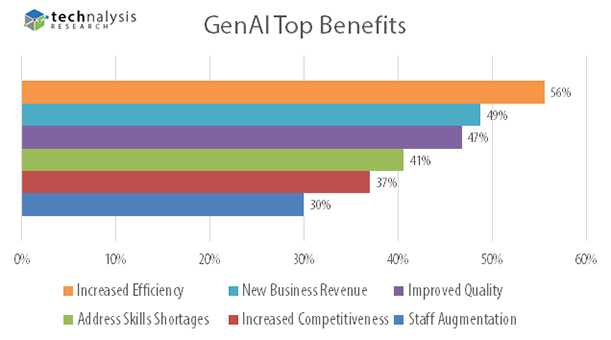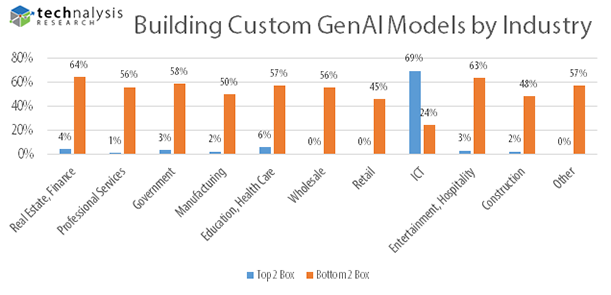July 27, 2023
By Bob O'Donnell
Everyone is talking about generative AI’s ability to impact businesses, but few have measured what companies are actually doing with this groundbreaking technology. That gap is now starting to be filled thanks in part to an in-depth study by TECHnalysis Research that dives into the details of how US-based businesses are using GenAI, including the types of applications, the vendor partners, implementations, benefits, concerns and more.
Entitled “A New Beginning: Generative AI in the Enterprise” the report is based on a survey of 1,000 US-based IT decision makers involved with their company’s GenAI efforts across ten industry verticals and two business sizes. As the title implies, and the study results confirm, GenAI is creating an entirely new level of expectations about how software applications work, how employees get their work done, how companies create and adapt their processes, and much more.
The report also uncovered a number of surprising facts about how businesses are currently deploying the technology. In addition, it revealed several gaps in the knowledge levels about and the deployment sophistication levels of GenAI, particularly across different industries.
At a high level, the results showed that a surprising 88% of US companies who participated in the survey are already using Generative AI tools, though only 7% have a formal policy about the technology. Interestingly, in the group of current non-users, about 10% have policies that strictly forbid its use.
The larger group that is using GenAI is excited about the opportunities it enables, with the key benefits shown in Figure 1. Over half the respondents (56%) cite increased efficiency and another 49% said the ability to enable new business models and revenue streams are key benefits of using the technology.

Fig. 1
Even those deploying GenAI have concerns about it, however, with 55% noting potential issues with security and protection of their corporate data, a similar number citing inaccuracies in the output data that foundation models can generate, and a nearly equal number (53%) voicing concerns about copyright. Not surprisingly, those not using GenAI had relatively similar concerns, with 70% saying that copyright issues were a problem and 64% citing IP leakage as reasons why they’re not using the technology. In addition, another 52% of the group said they didn’t have sufficient skill sets within their organizations to leverage GenAI—one of several data points from the survey that highlighted the huge education gap that many businesses are facing with this advanced new technology.
It is interesting to note that even among this group of skeptics, only 7% said they had no interest in ever deploying the technology—the remaining 93% kept the possibility open at some point down the road.
One of the biggest points of variety among survey respondents was the types of GenAI-enabled applications they were running, particularly across different vertical industries. At a top level, productivity and content generation-related applications like word processors were the most commonly used, but in some industries it was applications like software coding or CRM (Customer Relationship Management) tools that were the first choice.
Even more interesting is that when respondents were asked to rank the value of similar (though not identical) GenAI-powered product categories, there often even differences between what companies valued and what they’re currently using. This suggests that many companies have ideas about the types of GenAI-related applications they’d like to be able to run, but haven’t found solutions that fit their needs just yet. It’s one of many data point from the study that highlight the fact that we’re still in the very early stages of GenAI adoption and there are still plenty of opportunities for vendors to create new or enhanced solutions to meet those customer needs.
One of the most dramatic examples of variations among industries had to do with the potential of a company building their own GenAI model. There’s been a great deal of conversations about the desire for companies to leverage their own data to customize GenAI models—a fact borne out in the study as well—and some have even gone on to speculate about a large interest in creating custom models. In reality, however, the study results made it clear that most businesses don’t currently have any interest in this more advanced application—with one notable exception.
As Figure 2 clearly illustrates, it was only the tech-focused ICT (Information, Communications and Technology) vertical that was interested in doing this, but they were very interested. In every other industry, a tiny single-digit percentage of companies said they were very or somewhat likely to build their own custom GenAI models but in ICT that number skyrocketed to 69%.

Fig. 2
The results make it clear that only technically advanced companies appreciate the importance and opportunity that a custom GenAI model might enable and that there’s a huge gap in education about more sophisticated GenAI deployments that’s going to need to be overcome.
The fact that GenAI has already gone mainstream opens up a huge number of exciting opportunities for vendors participating in this red-hot market. But as these and other results from the study demonstrate, it’s going to take a lot of education, targeted offerings and more to make GenAI a consistently useful and powerful offering for businesses of all types.
You can download the summary highlights of the Generative AI in the Enterprise study for free at this link: https://technalysisresearch.com/downloads/TECHnalysis Research Generative AI in Enterprise Survey Highlights.pdf
Here’s a link to the original column: https://www.linkedin.com/pulse/generative-ai-study-uncovers-surprising-facts-usage-bob-o-donnell
Bob O’Donnell is the president and chief analyst of TECHnalysis Research, LLC a market research firm that provides strategic consulting and market research services to the technology industry and professional financial community. You can follow him on LinkedIn at Bob O’Donnell or on Twitter @bobodtech. |